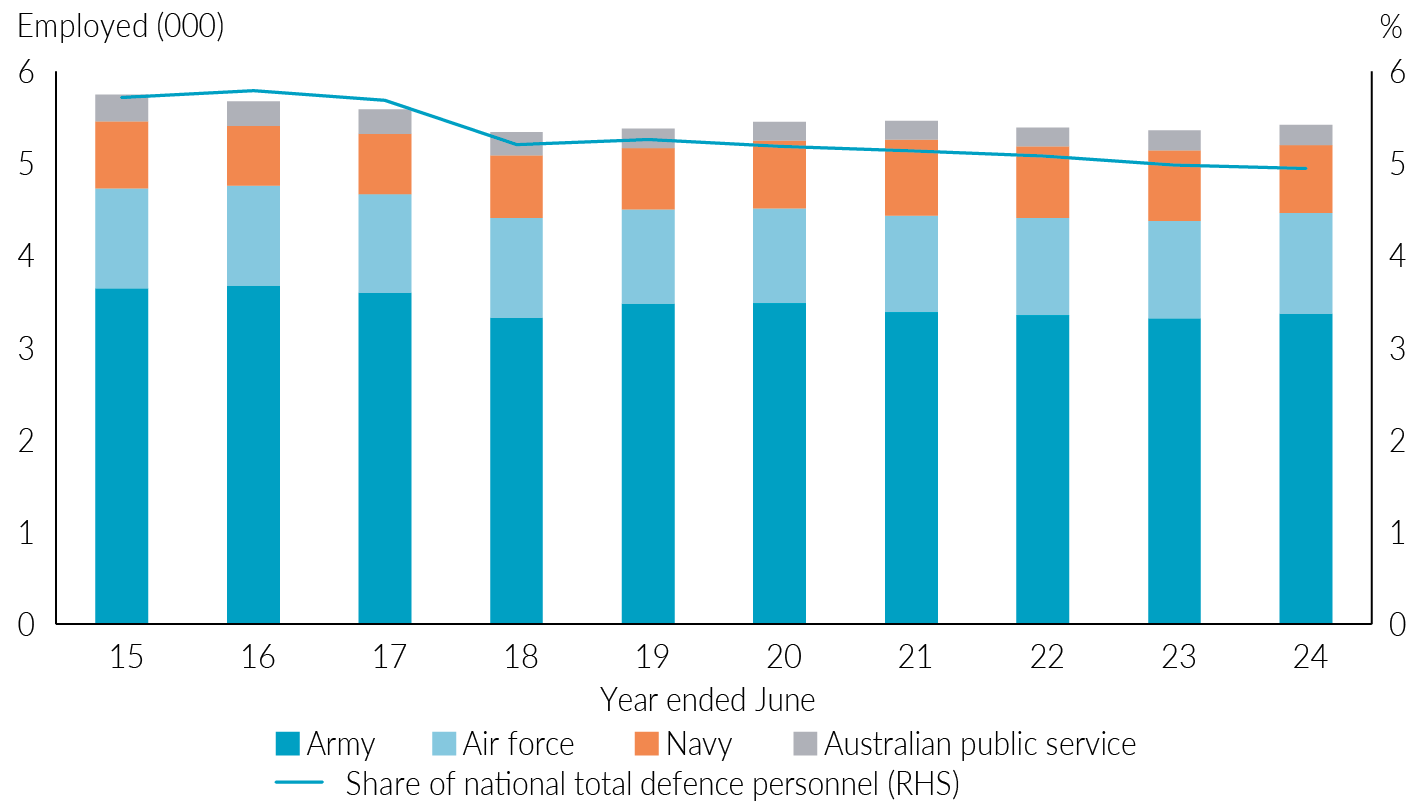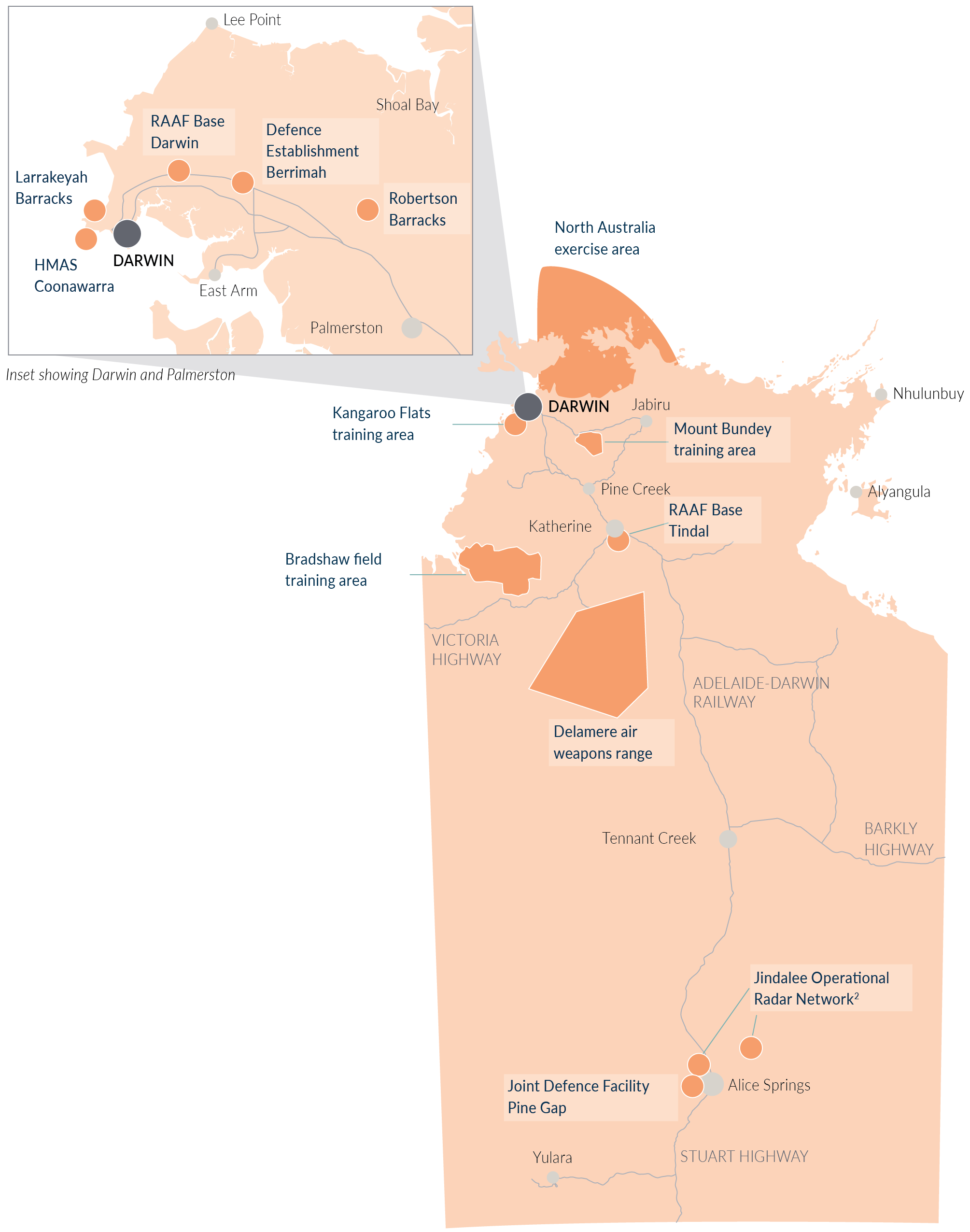Defence
Outlook
Ongoing defence investment in the Territory remains critical to national and regional security for Australia and its strategic partners amid growing competition for influence in the Indo-Pacific region.
The Territory is a critical defence and national security hub for Australia and its strategic partners, with considerable defence assets and personnel operating and being supported in the Territory. The Territory is also host to significant international military training exercises, bringing together Australian and international defence personnel and assets.
An estimated $7.3 billion in defence infrastructure investment is planned over the decade, comprising $5.96 billion in approved planned investment and $1.37 billion in unapproved planned investment.
Ongoing defence investment and activity in the Territory will remain important to Australia given the Territory’s strategic location and growing competition for influence in the Indo-Pacific region.
Employment and personnel
The number of Australian defence persons stationed in the Territory increased by 1.2% in 2023‑24 to around 5,420 persons, with an increase across permanent and reserve forces as well as public service personnel (Chart 10). Total defence personnel in the Territory accounted for about 4.9% of the national total in 2023-24, although permanent defence forces in the Territory was higher at about 7.3% of the national total.
While the number of Australian defence personnel in the Territory has remained relatively stable over the last five years, the composition has changed with an increase in the number of reserve forces partly offset by decreases in permanent forces. By military branch, the Territory has seen a higher number of air force and navy personnel and a lower number of army personnel.
From 2024-25, the composition of defence personnel stationed in the Territory will continue to evolve with the 5th Battalion Royal Australian Regiment’s relinking with 7th Battalion in Darwin, and the 1st Aviation Regiment relocating from Darwin to Townsville.
As part of the Army’s restructuring from generalised to specialised combat brigades, the 1st Brigade which is based in Darwin, will also transition towards a light combat brigade that can be quickly deployed in the littoral environment.
Chart 10: Defence employment in the Territory
RHS: right-hand side
Source: Department of Defence Annual Report; Department of Treasury and Finance
International cooperation
The Territory maintains a vital role in strengthening Australia’s international cooperation with its allied partners and supporting Australia’s defence strategy. The Territory’s strategic location, expansive landscape and diverse training areas allow for the operation of large-scale military training and exercises, as well as the hosting of international forces.
Since 2012, the Territory has hosted the US Marine Rotational Forces–Darwin (MRF-D), a deployment of US marines aimed at enhancing Australia and US defence cooperation, interoperability and regional security. Over the years, the MRF-D has grown in size, complexity and capability, and numbered around 2,500 personnel in early 2025.
In late 2024, Australia, the US and Japan committed to enhancing defence cooperation, which will see the participation of Japanese ground self-defence forces in annual training activities with Australia and the MRF-D.
To strengthen its defence alliances and enhance the skills of its military personnel, Australia routinely participates in military exercises. The Territory hosts annual and bi-annual international military exercises including:
- Exercise Predator’s Run, a littoral-focused multilateral training exercise with Australian, US, UK and Phillipine forces
- Exercise Talisman Sabre, led by the Australian forces and US military, with an increasing contribution from Japan
- Exercise Pitch Black, a large-scale air combat exercise
- Exercise Kakadu, an international maritime engagement exercise.
These exercises bring together numerous nations and strengthen international alliances, while establishing the Territory as an important location for defence training in the Indo-Pacific region.
Projects
Significant defence projects are being delivered in the Territory over the decade with an estimated $5.96 billion of approved planned investment projects underway and an estimated $1.37 billion of unapproved planned investment (Table 2).
These projects continue to support the growth of the local defence industry with Territory businesses across areas such as construction, maritime and aerospace becoming key partners in delivering defence programs and providing local solutions to allied partners training in the region.
Defence tenders also incentivise large international firms to invest in the Territory, bringing with them expertise and experience that support the local defence industry. Defence, by fostering links between international and local firms, provides the opportunity for local businesses to integrate into the global supply chain.
Defence projects extend across the air force, navy and army, and across major defence sites in the Territory (Map 3).
Table 2: Defence approved and unapproved planned investment
| Planned investment | $M |
|---|---|
| RAAF Base Tindal redevelopment stage 6 and United States Force Posture Initiatives (USFPI) airfield and infrastructure works | 1582 |
| USFPI Northern Territory training areas and ranges upgrades | 747 |
| Larrakeyah Defence Precinct Redevelopment Program | 602 |
| NAVFAC Darwin Aircraft Maintenance Facilities Program | 380 |
| Robertson Barracks base improvements Project | 389 |
| RAAF Darwin and Mount Bundey airfield capital works | 352 |
| Facilities to support remotely piloted aircraft system | 314 |
| Navy capability infrastructure sub-program: offshore patrol vessel facilities | 287 |
| RAAF Base Tindal aircraft parking apron | 205 |
| Facilities to support enhanced defence communications | 160 |
| RAAF Base Darwin mid-term refresh | 160 |
| Other1 | 782 |
| Total approved planned investment | 5 960 |
| Guided weapons and explosive ordnance storage and distribution | 200 |
| Theatre Logistics Estate Sub-Program | 185 |
| National Maritime Infrastructure Maintenance Program | 100 |
| RAAF Base Tindal aircraft maintenance support facility | 60 |
| Other | 826 |
| Total unapproved planned investment | 1 371 |
| Total planned investment | 7 331 |
1 Includes planned investment for Cocos Islands airfield upgrades
Source: Department of Treasury and Finance; Department of Chief Minister and Cabinet; Department of Defence Annual Report
For the latest information on the Territory’s defence sector, refer to the Territory Economy and DefenceNT websites.
Map 3: Major defence sites in the Territory
1 This map is produced from various sources. Department of Treasury and Finance cannot guarantee the accuracy, currency, or completeness of the information. To be used as a guide only.
2 The Jindalee Operational Radar Network has 2 operating facilities within the Alice Springs region, at Harts Range and Mount Everard.
Source: Department of Treasury and Finance; Department of Chief Minister and Cabinet; Department of Defence


